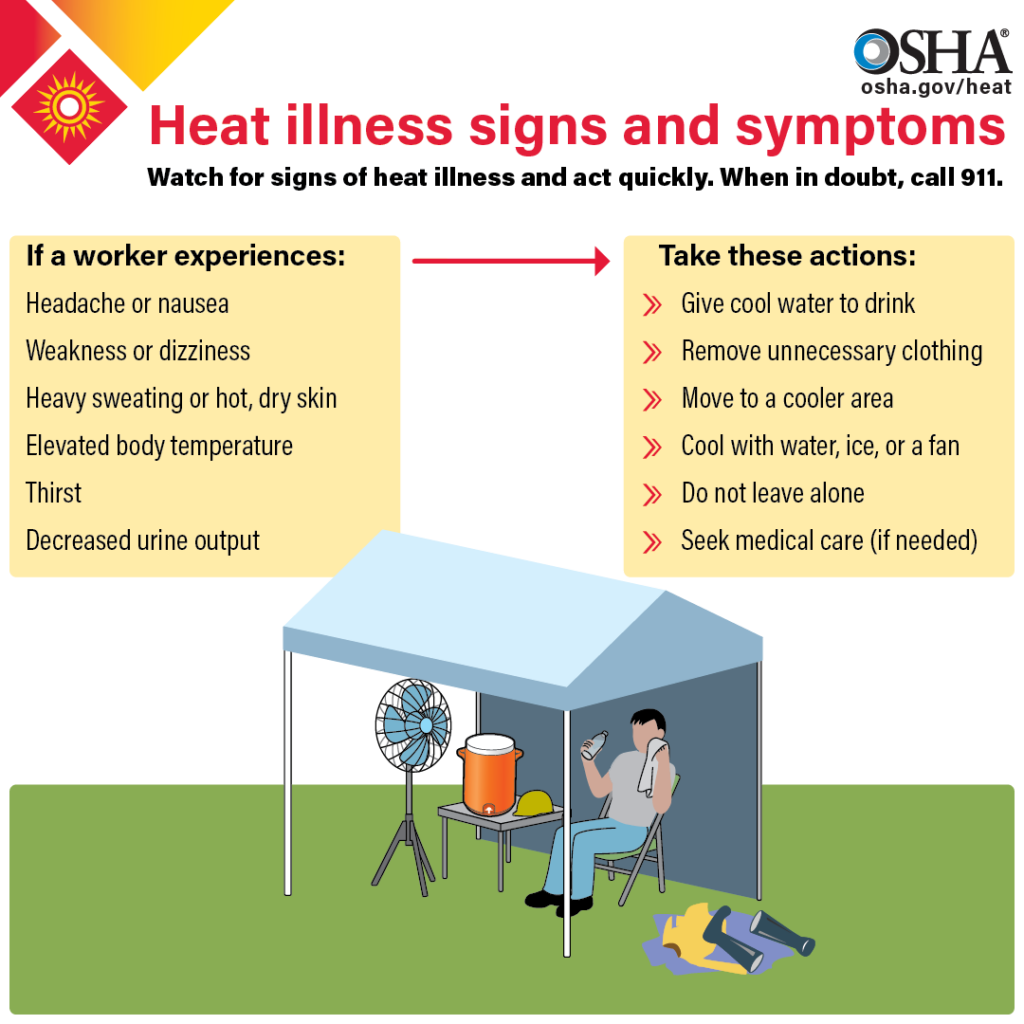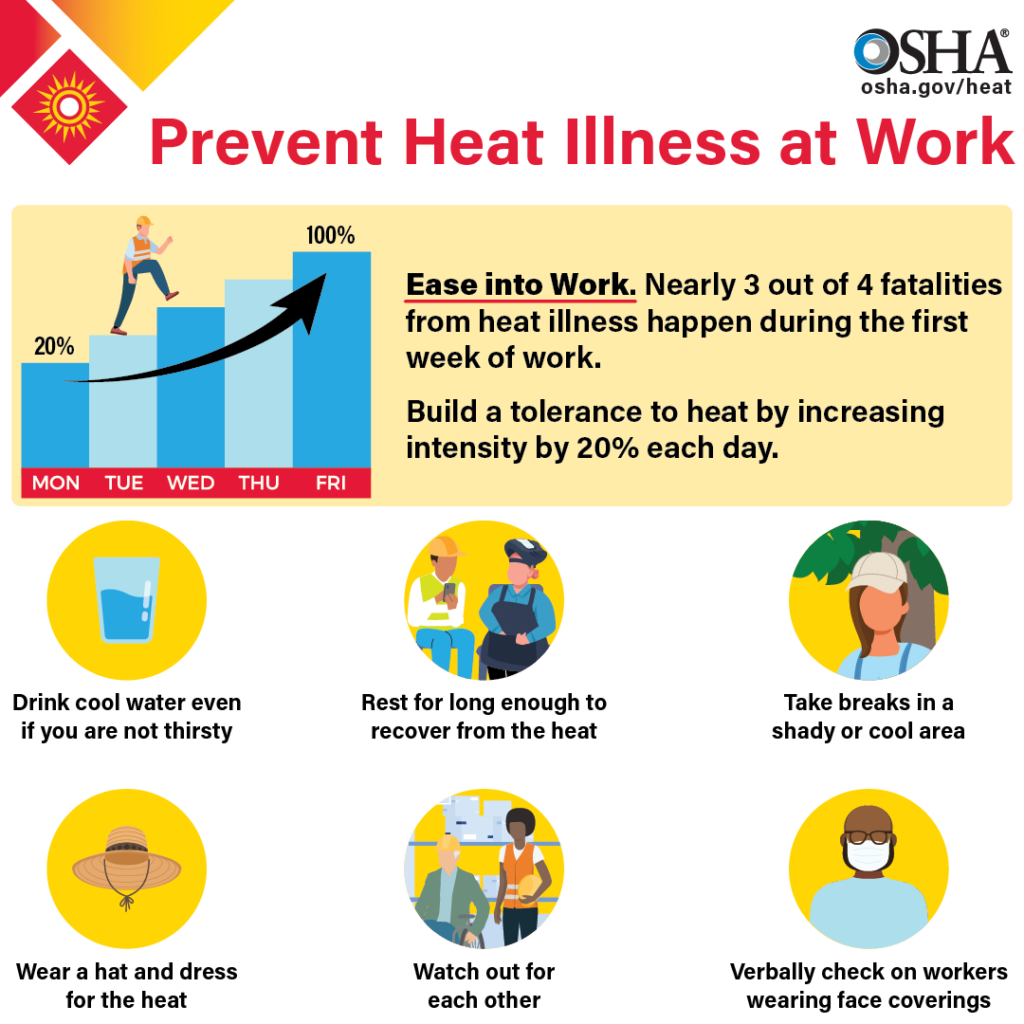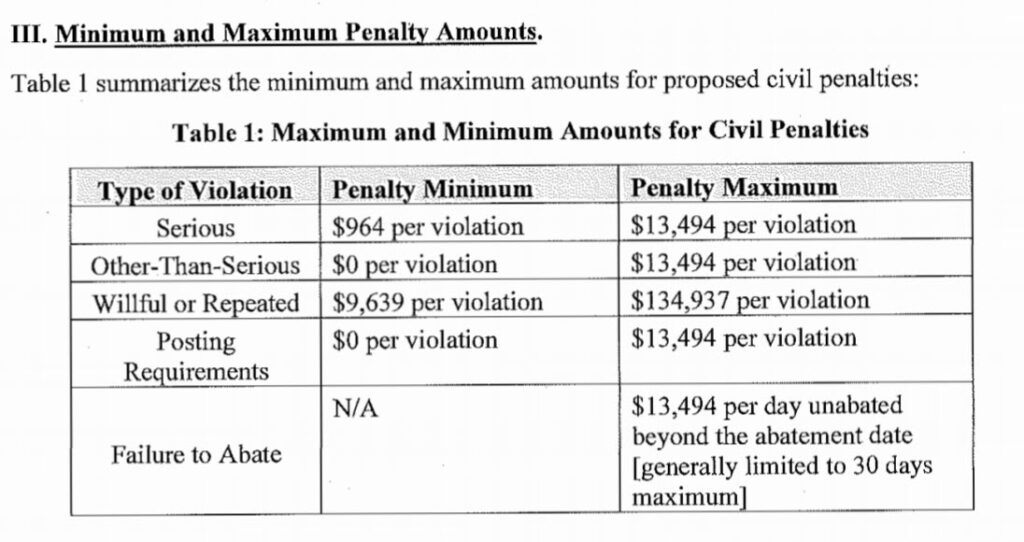
Let us help you make sense of PSM / RMP!
We’ll be having an open-enrollment PSM class in Burleson, Texas July 8th-11th 2025.
You can get more information on the class with this link.
We hope to see you there!
Chill - We Got This!

Let us help you make sense of PSM / RMP!
We’ll be having an open-enrollment PSM class in Burleson, Texas July 8th-11th 2025.
You can get more information on the class with this link.
We hope to see you there!
OSHA has announced that they will be ramping up enforcement of their Heat Stress initiative under the General Duty clause.
US Department of Labor announces enhanced, expanded measures to protect workers from hazards of extreme heat, indoors and out
Part of an interagency Biden-Harris administration effort to protect workers, communitiesWASHINGTON – To combat the hazards associated with extreme heat exposure – both indoors and outdoors – the White House today announced enhanced and expanded efforts the U.S. Department of Labor is taking to address heat-related illnesses.
…OSHA Area Directors across the nation will institute the following:
- Prioritize inspections of heat-related complaints, referrals and employer-reported illnesses and initiate an onsite investigation where possible.
- Instruct compliance safety and health officers, during their travels to job sites, to conduct an intervention (providing the agency’s heat poster/wallet card, discuss the importance of easy access to cool water, cooling areas and acclimatization) or opening an inspection when they observe employees performing strenuous work in hot conditions.
- Expand the scope of other inspections to address heat-related hazards where worksite conditions or other evidence indicates these hazards may be present.
In October 2021, OSHA will take a significant step toward a federal heat standard to ensure protections in workplaces across the country by issuing an Advance Notice of Proposed Rulemaking on heat injury and illness prevention in outdoor and indoor work settings. The advance notice will initiate a comment period allowing OSHA to gather diverse perspectives and technical expertise on topics including heat stress thresholds, heat acclimatization planning, exposure monitoring, and strategies to protect workers.
The agency is also working to establish a National Emphasis Program on heat hazard cases, which will target high-risk industries and focus agency resources and staff time on heat inspections. The 2022 National Emphasis Program will build on the existing Regional Emphasis Program for Heat Illnesses in OSHA’s Region VI, which covers Arkansas, Louisiana, New Mexico, Oklahoma and Texas.



It’s important to ensure you have a properly implemented Heat Stress program including:
Source: DOL on Twitter and at their Website.
WASHINGTON, DC – The U.S. Department of Labor has announced adjustments to Occupational Safety and Health Administration (OSHA) civil penalty amounts based on cost-of-living adjustments for 2021.
In 2015, Congress passed the Federal Civil Penalties Inflation Adjustment Act Improvements Act to advance the effectiveness of civil monetary penalties and to maintain their deterrent effect. Under the Act, agencies are required to publish “catch-up” rules that adjust the level of civil monetary penalties, and make subsequent annual adjustments for inflation no later than January 15 of each year.
OSHA’s maximum penalties for serious and other-than-serious violations will increase from $13,494 per violation to $13,653 per violation. The maximum penalty for willful or repeated violations will increase from $134,937 per violation to $136,532 per violation.
Visit the OSHA Penalties page for more information. The Department of Labor Federal Civil Penalties Inflation Adjustment Act Annual Adjustments for 2021 final rule is effective January 15, 2021, and the increased penalty levels apply to any penalties assessed after January 15, 2021.
Under the Occupational Safety and Health Act of 1970, employers are responsible for providing safe and healthful workplaces for their employees. OSHA’s role is to help ensure these conditions for America’s working men and women by setting and enforcing standards, and providing training, education and assistance. For more information, visit www.osha.gov.
The mission of the Department of Labor is to foster, promote, and develop the welfare of the wage earners, job seekers, and retirees of the United States; improve working conditions; advance opportunities for profitable employment; and assure work-related benefits and rights.
While I’m sure the next few years are going to be very interesting from a regulatory standpoint, this is just he annual change to reflect inflation.
The Obama administration signed the Federal Civil Penalties Inflation Adjustment Act Improvements Act of 2015 which requires OSHA to adjust their fine amounts for inflation. 2020’s numbers are in: OSHA will adjust the fines by the Consumer Price Index cost-of-living adjustment multiplier of 1.01764 which turns into a $230 increase for Serious and a $2300 increase for Willful / Repeat. The table below shows the new penalty amounts.

Memo File: 2020 OSHA Annual Adjustments

The view that PSM is a time-sink.
A common push-back from facilities that are covered under the OSHA PSM and EPA RMP regulations is the sheer amount of resources these programs require to successfully design, implement, and maintain.
One phrase, seared into my memory, is from a frustrated and over-burdened maintenance manager: “PSM is a thief!”
He was referring to the fact that he had to task high-performing, highly trained and highly compensated personnel to perform Process Safety tasks. Time spent on Process Safety is obviously time that isn’t spent elsewhere.
My counterpoint at the time was “Safety isn’t earned – it is rented. And the rent is due every damned day”
After an experience I had last week, I think there’s a better way to respond. I’d like to share my new response with you, but first let’s talk about the experience that made me see a new way of approaching this issue.
The experience
During the recent RETA conference the guest speaker was Jóse Matta. Jóse suffered ammonia burns over 40+ percent of his body when a condenser failed in an overpressure event. The event involved a portable ammonia refrigeration system. Before transport the system is drained of ammonia. In this incident, the driver placed a cap on the relief valve outlet due to DOT concerns. However, once the unit arrived onsite, the capped relief valve wasn’t noticed. Eventually this led to an overpressure event once the unit was charged and started.
Jose Matta barely survived his exposure. He nearly died in the hospital. His wife was brought into the burn unit to say her final goodbyes to her husband – the father of their children. When he was lucky enough to survive, he had to endure multiple surgeries. He no longer has a sense of smell and can barely taste food. He no longer has the ability to sweat and has to constantly monitor his condition when it’s hot out to avoid heat-stress or heat-stroke.
What does Jose’s experience have to do with “PSM as a thief?”
Post-incident, several failures of the PSM program were noted:
If the Process Safety items above were properly in place, the incident either wouldn’t have happened, or the outcome would have been significantly better for Jóse.
You see, when I pushed back from the “PSM is a Thief” argument before, I was wrong. I should have agreed with that statement.
PSM *is* a thief. Yes, it takes resources, but it can also take a LOT more from you!

PSM can steal from you: the opportunity to nearly die in a chemical release.
PSM can steal from your family: the opportunity for tearful goodbyes.
PSM can steal from you: years of surgeries, painful rehabilitation, and diminished health.
Yeah, PSM is a thief. I’m plenty happy to have these experiences stolen from me and the people I work with.
Without Process Safety, people are taking risks without knowing they are taking them. NOBODY should have to do that.
If you want your Process Safety program to steal these experiences from your facility, your coworkers, your neighbors, and YOU, we can help!
OSHA has posted a video on the “OSHA Inspection Process” to give you a general idea of what to expect during an OSHA inspection.
For my take on the subject, go to this earlier post.
If you need help preparing for, managing, or dealing with the aftermath of an OSHA or EPA inspection, please contact us.
Back in 2017 I posted on how to answer an OSHA document request from the published NEP.
OSHA’s published CPL-03-00-021 – “PSM Covered Chemical Facilities National Emphasis Program” includes an example document request list that often correlates fairly well to the one that OSHA inspectors provide during an NEP inspection.
Recently, a friend sent me the Document Request they received at the onset of the inspection which was quite a bit different from that PSM ChemNEP. Here’s what I noticed reviewing this new document:
I took that request and modified it to show how I would answer the 110 questions if you were using my PSM programs. You can download the 13 page, 4,500 word Microsoft Word monstrosity through the following link: 0419 OSHA Document Request.
Just a few general warnings about questions and document requests:
If you need help preparing for, managing, or dealing with the aftermath of an OSHA or EPA inspection, please contact us.
First, what is a Repeat Citation? Here’s what OSHA has to say about it in their Field Operations Manual or FOM:
An employer may be cited for a repeated violation if that employer has been cited previously for the same or a substantially similar condition or hazard and the citation has become a final order of the Occupational Safety and Health Review Commission (OSHRC). A citation may become a final order by operation of law when an employer does not contest the citation, or pursuant to court decision or settlement. The underlying citation which the repeated violation will be based on must have become a final order before the occurrence or observation of the second substantially similar violation. (OSHA FOM Chapter 4, Section VII(A)(1). Pg. 4-21&4-22)
A Repeat violation is essentially exposing your employees to the same (or substantially similar) conditions or hazards after your company has previously been cited for the same (or substantially similar) conditions or hazards. Note that this is about your company and not your facility. If you are working for Billy Bob’s Cold Storage and they have four facilities, you may well be subject to a Repeat citation based on a citation issued at one of the other facilities. For Federal OSHA, the citation must have been made by Federal OSHA, not a state plan:
Federal Repeat Citations cannot be based on prior citations from State Plans (OSHA FOM Chapter 4, Section VII(A)(2). Pg. 4-22)
.
OSHA needs to establish three things to establish a Repeat violation:
.
Condition Substantially Similar:
They are issued based on similar conditions or hazards, not based on identical OSHA standard (OSHA FOM Chapter 4, Section VII(B) & VII(B) Pg. 4-22)
They CAN be issued for General Duty Citations (OSHA FOM Chapter 4, Section III(E). Pg. 4-18)
The key to understanding this is that it is NOT based on the particular OSHA Standard or Rule, it is based on the conditions / hazards. This is particularly important under PSM because a single condition or hazard may be cited under several different portions of the PSM Standard or Rule. As an example, let’s say that you were previously cited under PSM 29CFR1910.119(l)(5) for lacking an SOP for a new piece of equipment that was installed. The condition or hazard is not providing an SOP for a piece of equipment that operators are expected to operate. However, it’s important to note that the same condition or hazard could have been cited under 29CFR1910.119(e)(1), 29CFR1910.119(e)(3)(i), 29CFR1910.119(f), 29CFR1910.119(f)(2), 29CFR1910.119(f)(3), 29CFR1910.119(g)(1)(i), 29CFR1910.119(l)(2)(iii), 29CFR1910.119(i)(2)(ii), etc. Remember, it’s about the condition or hazard, not the individual OSHA rule.
.
Previous Citation is Final:
… the citation has become a final order of the Occupational Safety and Health Review Commission (hereafter,OS&H Review Commission). A citation may become a final order by operation of law when an employer does not contest the citation, or pursuant to court decision or settlement. The underlying citation which the repeated violation will be based on must have become a final order before the occurrence or observation of the second substantially similar violation. (OSHA FOM Chapter 4, Section VII(A)(1). Pg. 4-21&4-22)
While that seems like a minor legalistic issue, it’s one of extreme importance if you have been cited for an OSHA violation. Let’s imagine a situation where your facility is cited for a training issue. While you certainly want to address that issue as soon as possible, it may be wise to delay the settlement of the OSHA violation until you can address the same issue in your sister facilities as well. Settling quickly with OSHA may expose those sister facilities to Repeat violations.
.
You actually came into compliance after the first citation:
They are different from “Failure to Abate” citations. If an employer never came into compliance after an initial OSHA’s initial inspection / citation, that is a “Failure to Abate.” If the violation was corrected, and then later reoccurs, that is a Repeated violation. (OSHA FOM Chapter 4, Section VII(F) Pg. 4-23)
This is only really a matter of the associated fine. If the citation is Repeat, the fine is capped at about $129k. If the citation is actually a Failure to Abate, the fine is capped at $12.9k a day for up to 30 days or $387k.
.
Why are we seeing more Repeat citations?
Inspectors are being told to specifically look for these issues:
During inspections, CSHO’s must pay particular attention to identifying instances of Repeated violations from season to season or past occupancy. (OSHA FOM Chapter 12, Section II(F)(3) Pg. 12-3)
During the course of the ChemNEP inspection, the CSHO shall review abatement for all PSM citations issued within the previous six years to determine whether the hazard still exists. (OSHA CPL 03-00-021, Section XI(E)(10) Pg. 31)
.
What are the ramifications of a Repeat citation?
The fines can be up to $129,336 for each Repeated citation. (OSHA Act of 1970, Section 17) (OSHA Website on Penalties)
A single Repeat citation involving a fatality can place you in the Severe Violator Enforcement Program (SVEP). Two or more Repeat citations can place you in the SVEP if you have a “High Emphasis Hazard” as outlined in CPL 02-00-149 (which includes PSM facilities) (OSHA FOM Chapter 11, Section II(M)(2)(a) Pg. 11-13)
SVEP cases often spread to the entire region or even the entire country if the facility has sister facilities in other areas. OSHA may choose to inspect those other facilities or issue an abatement demand for ALL the sister facilities based on conditions found at SOME of them. Furthermore, OSHA “shall consider going beyond the subject of the citations to include additional safety and health program enhancements,” even for items that were not cited during the inspection. (CPL 02-00-152)
No reduction shall be given for repeated violations. If a repeated violation is found, no reduction for good faith can be applied to ANY of the violations found during the same inspection. (OSHA FOM Chapter 6, Section III(B)(3)(a) Pg. 6-7)
Each repeated violation is evaluated as serious or other-than-serious, based on current workplace conditions, and not on hazards found in the prior case. (OSHA FOM Chapter 6, Section V(A)(1) Pg. 6-11)
Repeat violations can be the basis of 11B enforcement action where the US Court of Appeals is asked to enforce the order. (OSHA FOM Chapter 15, Section XIV(B)(3) Pg. 15-14)
Obviously, there’s a lot of dollar signs involved, but that’s just the start of the possibilities. The real damage can come from becoming enrolled in the Severe Violator Enforcement Program or SVEP. The SVEP program is a nightmare that you want to avoid. I really can’t summarize it better than Eric Cohn did at OSHA Defense Report.
An employer is entered into SVEP at the outset of an OSHA case, prior to an opportunity to defend itself and prove wrong OSHA’s alleged violations. Notwithstanding this end run around Constitutional Due Process, once in the program, SVEP employers are immediately subject to:
- Public shaming by OSHA through both an inflammatory, embarrassing, and one-sided press release detailing the alleged violations and by posting the employer’s name on a Severe Violator list on OSHA’s public website;Severe Violator Image
- Mandatory follow-up inspections at that cited facility and up to ten sister facilities within the organization; and
- More expansive settlement terms than ever before, including corporate-wide requirements.
.
How far back can OSHA look for a previous citation to use as the basis for a Repeat?
Short answer – As long as they want. Long answer:
Although there are no statutory limitations on the length of time that a previously issued citation can be used as a basis for a repeated violation, it is OSHA policy that they are only to be issued withing five years of the final order date of the previous citation or within five years of the final abatement date, whichever is later, or five years from the issue of a final order from the OS&H Review Commision or final mandate from the US Court of Appeals. (OSHA FOM Chapter 4, Section VII(E)(1) Pg. 4-23)
Recent Court rulings have shown that since there are no statutory limitations on the Look-Back period, OSHA could issue Repeat citations based on citations older than five years. (OSHRC Triumph Construction)
Under OSHA Commission precedent, the “time between violations does not bear on whether a violation is repeated.” (OSHRC Hackensack Steel)
This long reach means that you need to know your history – and the history of your sister facilities.
.
While we certainly hope you never get cited by OSHA for a PSM violation, if it does happen, please don’t hesitate to contact us.
.
Sources: OSHA FOM, CPL 02-00-149 (SVEP), CPL 02-00-152, CPL 03-00-021, OSHA Act of 1970 (Judicial Review), OSHA Website on Penalties, OSHRC Triump Construction, OSHRC Hackensack Steel.
In a recent Federal Register notice, OSHA has announced updated fine amounts for 2018.
OSHA penalties for other-than-serious, serious and failure to abate violations increased by $319 from $12,615 per violation to $12,934 per violation.
The penalty for willful and repeat violations increased from $126,749 to $129,336, an increase of $2, 587.
The new penalty increase is effective immediately and will apply to any citations issued through the remainder of 2018.
Note: This only applies to Federal OSHA states but it’s very likely that State Plans will follow.